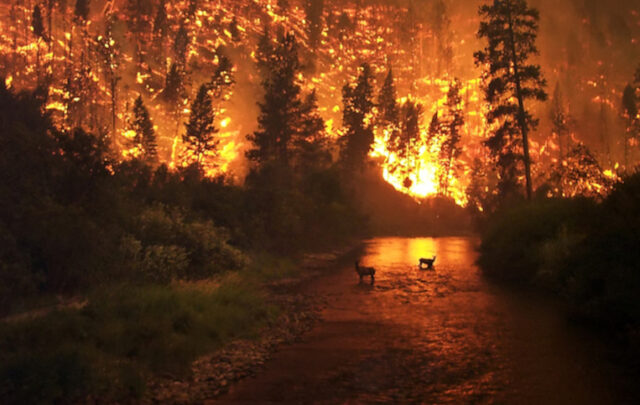
The year is 9014. While digging up the remains of our civilization, our distant descendants happen upon the painting below. You may recognize the work as Edward Hicks’ The Peaceable Kingdom, but what will future humans—or perhaps the mutant rats that have inherited the Earth—think of it? Many big-cat species may not survive two more decades, let alone seven millennia. What will future beings think of those two enormous felines, the one with spots and the other with a shaggy ring around its head?

It’s a fanciful scenario—the half-life of canvas can’t be very long without humans around to care for it—but artwork can be a rich source of ecological data. Approximately 30,000 years ago, humans painted the walls of the Chauvet Cave in southern France. Their images of the cave bear helped today’s scientists date the extinction of that animal to around 5,000 years after it was drawn.
Paleontologists are also debating whether rock artworks found across Africa depict a giant buffalo called Syncerus antiquus, possibly proving the species survived thousands of years longer than originally thought. The same goes for ancient images of extinct Australian megafauna like the giant kangaroo.
A new study, published Monday in the Proceedings of the National Academy of Sciences, does something similar albeit in a more complex way. Using 6,000 years’ worth of art and other records, researchers have constructed a model showing when different types of mammals appeared and disappeared in Egypt over that time period.
During the early Holocene, the area now known as Egypt hosted 37 large mammal species (i.e. those weighing nine pounds or more). Below is a ceremonial palette dating back to approximately 3150 B.C.E. that shows ostrich, wildebeest, and giraffe living in Egypt. There were also elephants, oryx, cheetahs, and antelope.

“You’d be forgiven for confusing ancient Egypt with modern-day East Africa,” says Justin Yeakel, a biologist with the Santa Fe Institute who coauthored the study. “It’s hard to imagine a more ecologically diverse place.”
What happened? We happened, for one thing. Many of the renderings portray humans hunting large mammals. There were also major changes in Egypt’s climate. Three successive periods of intense drought occurred between 5,000 and 3,000 years ago, and many wildlife populations couldn’t cope.
Only 8 of those 37 early Holocene mammal species remain in Egypt’s wild today: the Nubian ibex, Barbary sheep, slender-horned and dorcas gazelles, wild ass, striped hyena, red fox, and common jackal. Twenty-seven are locally extinct. Aurochs vanished from the Earth entirely in the 17th century, victims of overhunting. The scimitar-horned oryx, which suffered from both hunting and habitat loss, survives only in preserves and zoos.
The authors ran their observations through a mathematical model and provided proof of an environmental maxim: a diverse ecological community is a strong ecological community. As the number and variety of Egyptian mammal species declined, the surviving species became more vulnerable to extinction themselves. In other words, extinction begets extinction.
For example, Egypt once hosted small-bodied herbivores, such as gazelles. Those animals fed several carnivores, in what Yeakel refers to as a “nested” feeding relationship. Smaller carnivores like wild dogs would eat only gazelle-sized creatures or smaller. Larger carnivores, like cheetahs, would consume medium-sized herbivores as well as the smaller ones, and the largest meat-eaters, such as lions, would eat big, medium, and small herbivores. So when a single small herbivore became extinct or moved to greener pastures, a major source of food disappeared for multiple species. All the carnivores would then prey on the remaining herbivores of a similar size, putting additional pressure on those populations. Such disappearances would create a negative feedback loop, as an entire trophic level of the food chain collapsed.
“As you lose redundancy, each additional extinction has a larger impact,” says Yeakel.
The study also emphasizes the inherent vulnerability of large mammals. They need more food, have longer gestation periods, and birth fewer young. Whenever there was a change in climate or an uptick in hunting by humans in ancient Egypt, it was the larger animals—the lions, the rhinoceroses, and such—that were the most likely to disappear.
And it’s those so-called “charismatic megafauna”—pandas, polar bears, and orcas, to name a few others—that we love to see in our photographs, air-brushed T-shirts, and documentary films. Our modern-day cave walls. Perhaps we’re just trying to preserve a record for future generations.






